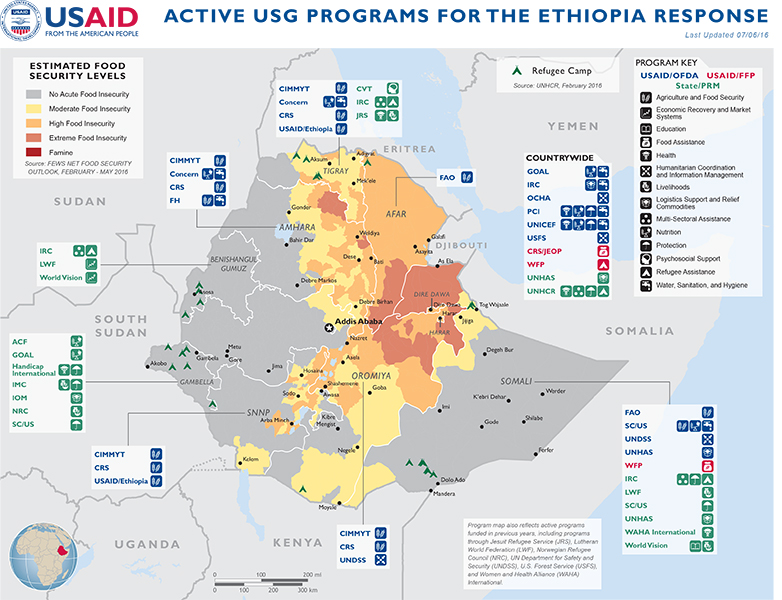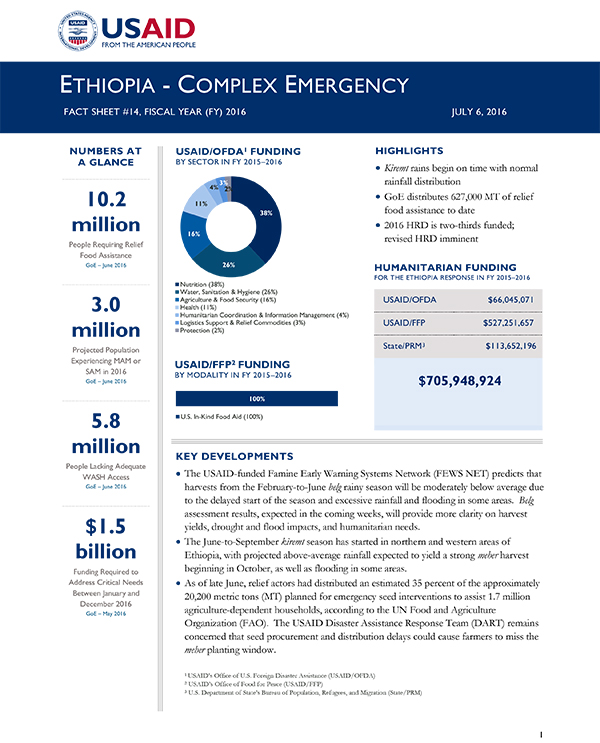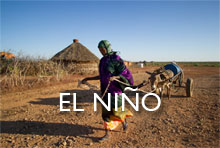- What We Do
- Agriculture and Food Security
- Democracy, Human Rights and Governance
- Economic Growth and Trade
- Education
- Ending Extreme Poverty
- Environment and Global Climate Change
- Gender Equality and Women's Empowerment
- Global Health
- Water and Sanitation
- Working in Crises and Conflict
- Disaster Assistance
- Political Transition Initiatives
- Conflict Mitigation and Prevention
- Countering Violent Extremism
- Disaster Risk Reduction
- Peacebuilding and Reconciliation
- Providing Safe & Secure Environments for Development
- Recovering From Crisis
- Resilience
- Tech Challenge for Atrocity Prevention
- World Humanitarian Day
- U.S. Global Development Lab
July 6, 2016
Highlights
Kiremt rains begin on time with normal rainfall distribution
GoE distributes 627,000 MT of relief food assistance to date
2016 HRD is two-thirds funded; revised HRD imminent
Key Developments
Ethiopia Map - 07-06-2016 ![]() (pdf - 782k)
(pdf - 782k)
Numbers At A Glance
10.2 million
3.0 million
5.8 million
$1.5 billion
Humanitarian Funding
For the Ethiopia Response
FY 2015 - 2016
| USAID/OFDA | $64,045,071 |
| USAID/FFP | $527,251,657 |
| State/PRM | $113,652,196 |
| TOTAL | $705,948,924 |
The USAID-funded Famine Early Warning Systems Network (FEWS NET) predicts that harvests from the February-to-June belg rainy season will be moderately below average due to the delayed start of the season and excessive rainfall and flooding in some areas. Belg assessment results, expected in the coming weeks, will provide more clarity on harvest yields, drought and flood impacts, and humanitarian needs.
The June-to-September Kiremt season has started in northern and western areas of Ethiopia, with projected above-average rainfall expected to yield a strong meher harvest beginning in October, as well as flooding in some areas.
As of late June, relief actors had distributed an estimated 35 percent of the approximately 20,200 metric tons (MT) planned for emergency seed interventions to assist 1.7 million agriculture-dependent households, according to the UN Food and Agriculture Organization (FAO). The USAID Disaster Assistance Response Team (DART) remains concerned that seed procurement and distribution delays could cause farmers to miss the meher planting window.
CURRENT EVENTS
As of June 22, the Government of Ethiopia (GoE) and international donors had funded approximately 67 percent of the 2016 Humanitarian Requirements Document (HRD), requesting an estimated $1.5 billion to meet relief food and other critical needs during 2016, according to the UN. A funding gap of $518 million remains, and the GoE plans to release a revised appeal in July, following the compilation and review of belg assessment results.
Weather conditions associated with the projected 2016/17 La Niña climatic event—varying from dryness to above-average rainfall—could potentially affect up to 282,500 people, particularly in flood-prone and lowland areas of Ethiopia, according to USAID/OFDA partner FAO. Pastoral livelihoods are at risk of further deterioration, given the likely brief recovery period between the 2015/16 El Niño-triggered drought and expected La Niña climatic impacts.
FAO reports that flooding associated with the El Niño climatic event has damaged more than 55,000 hectares of land, primarily used for pasture, in Afar, Amhara, Oromiya, Somali, and Southern Nations, Nationalities, and Peoples (SNNP) regions since late April. Above-average belg rainfall and associated flooding in April and May also impeded delivery of relief assistance to affected communities. To date, seasonal rains have replenished water sources and revived pasture in some areas, but excessive Kiremt rainfall could result in additional flooding, related population displacement, livestock deaths, damage to crops, and limited humanitarian access, according to FEWS NET.
FEWS NET predicts that harvests from the belg rainy season will be moderately below average due to the delayed start of the season, excessive rainfall and flooding in some areas, and possible seed shortages. However, Kiremt seasonal rainfall began on time in much of Ethiopia; FEWS NET reports that the amount and distribution of rainfall is normal, except in eastern Oromiya, northern Somali, and some areas of SNNP. Overall, Kiremt rainfall is likely to be above average in northern Afar, Amhara, Benishangul Gumuz, Gambella, western Oromiya, and Tigray regions. Expected weak-to-moderate La Niña weather effects are likely to result in a 10–25 percent decline in September-to-December deyr rainfall in pastoral areas of southern and eastern Ethiopia, according to FEWS NET.
FOOD SECURITY
Populations in drought-affected areas, including southern Afar, Amhara’s Wag Himra Zone, Oromiya’s East Hararghe and West Hararghe zones, and pastoral areas of Somali’s Shinile Zone, are expected to continue experiencing Crisis—IPC 3—levels of food insecurity through at least September. 4 Food insecurity would be more severe absent current or programmed humanitarian assistance, FEWS NET reports. The number of people requiring relief food assistance is expected to begin declining with the onset of the meher harvest in October, given projections of above-average Kiremt rainfall.
To date, the GoE has distributed more than 627,000 MT of imported food supplies to drought-affected beneficiaries, despite bottlenecks at the Port of Djibouti and in transporting food supplies, according to the GoE National Disaster Risk Management Commission (NDRMC). The food supplies include relief food assistance, as well as stocks for GoE-led Productive Safety Net Program distribution. The NDRMC confirmed a stockpile of more than 451,000 MT of grain intended for delivery to drought-affected households, including more than 100,000 MT at the Adama, or Nazareth, regional hub as of June 27. The GoE Strategic Food Reserve Agency is working to increase its capacity across Ethiopia’s regional hubs from the current 405,000 MT to approximately 1.5 million MT by 2017. In addition, the Logistics Cluster—the coordinating body for humanitarian logistics activities, comprising UN agencies, non-governmental organizations (NGOs) and other stakeholders—has expanded warehousing capacity by constructing 24 mobile storage units in Afar, Gambella, and Oromiya. The mobile storage units are intended to expedite the dispatch of food commodities from regional warehouses to woredas, or districts.
Eighteen vessels, carrying more than 705,000 MT of food supplies, remained at anchor at the Port of Djibouti as of June 24, according to the Logistics Cluster. The Ethiopian Maritime Affairs Authority, which has designated staff to support supply-chain management at the port with assistance from international logistics experts, reports that outstanding GoE payments, lack of effective planning, and a shortage of trucks are contributing to delays dispatching and transporting cargo from the Port of Djibouti.
The GoE and relief actors had dispatched 85 percent and distributed 49 percent of the fourth round of relief food assistance, which began in early May, as of June 30. The UN World Food Program (WFP) reports that round four and five of relief food assistance are concurrently underway—each targeting an estimated 10.2 million people—with the fifth round beginning in mid-June. As of June 30, the GoE–WFP relief pipeline and the USAID-supported, Catholic Relief Services (CRS)-led Joint Emergency Operation (JEOP) had dispatched and distributed approximately 22 percent and 1 percent, respectively, of the fifth round.
AGRICULTURE
As of late June, relief actors had procured 63 percent of the approximately 20,200 MT planned for emergency seed interventions to assist 1.7 million households and distributed approximately 35 percent of the procured supplies, according to FAO. The emergency seed assistance is intended to provide drought-affected households with seeds for planting at the outset of the June-to-September Kiremt rainy season in anticipation of the meher harvest, which typically begins in October. The UN reports that the meher harvest typically produces an estimated 85 percent of Ethiopia’s food supply in Kiremt-receiving areas. With support from USAID/FFP, Food for the Hungry (FH) has procured 58 percent and distributed 33 percent of approximately 2,500 MT of seeds planned for seed interventions to date. Additionally, USAID/FFP partner the Relief Society of Tigray (REST) has procured 77 percent and distributed 72 percent of approximately 1,400 MT planned for seed interventions in Tigray.5 To date, USAID/OFDA partner the International Maize and Wheat Improvement Center (CIMMYT) has procured and distributed more than 99 percent—or nearly 2,700 MT of maize, sorghum, and wheat seeds—of the emergency seed supplies planned for households in Amhara, Oromiya, SNNP, and Tigray. As of June 28, USAID/OFDA partner CRS had procured 36 percent—or nearly 2,100 MT—of the emergency seed supplies planned for Amhara, Oromiya, SNNP, and Tigray and had not yet begun seed distributions.
DART staff assessed USAID-supported activities in northwest Amhara during the week of June 27. The DART and FAO, which leads the Emergency Seeds Working Group (ESWG), have expressed concern that the procurement and distribution of emergency seed supplies to vulnerable households are behind schedule, as the optimal planting window for several crops concludes in mid-to-late July, according to the GoE Ministry of Agriculture. In some areas of Ethiopia, the meher planting period for staple crops, such as chickpeas and teff, extends into August and early September. Procurement and distribution challenges reported by CRS and other stakeholders include the limited availability of certified seeds; elevated prices of some seed varieties; the limited number of seed suppliers; and delayed approval of seed quality by GoE zonal officials. FAO and other agriculture stakeholders plan to work with NGOs to address these concerns with GoE officials and donors to facilitate the timely procurement and distribution of critical seed supplies. Alternatives to the direct distribution of seeds include cash or voucher assistance and seed fairs; GOAL and Oxfam are piloting a seed voucher program and plan to share findings with the ESWG in the coming weeks. FAO and the ESWG also plan to conduct a post-distribution assessment of seed interventions to inform future response activities.
HEALTH, NUTRITION, AND WASH
Between January and April, USAID/OFDA partner Concern reached more than 91,500 vulnerable children younger than five years of age and pregnant and lactating women in Amhara and Tigray through community-based management of acute malnutrition (CMAM) activities. Concern is increasing its geographic coverage for CMAM interventions—including community mobilization, trainings for health workers, and establishment of supplementary feeding programs and treatment facilities—from 22 to 32 districts in the coming weeks. The expansion coincides with an anticipated spike in nutrition-related needs during the lean season. Concern is complementing its nutrition programs by supporting basic health care and WASH activities and providing emergency seed supplies to 111,500 households across 16 districts in Amhara and Tigray.
Mobile health and nutrition teams operated by USAID/OFDA partner the UN Children’s Fund (UNICEF) continue to provide critical health and nutrition services for vulnerable, hard-to-reach pastoral households in Afar and Somali. UNICEF mobile teams—composed of four people, typically nurses and health extension workers—treated a total of 22,400 moderate acute malnutrition cases across the two regions between January and April. The teams deliver a core package of preventive and curative support, including emergency nutrition services, disease surveillance, health care referrals, hygiene promotion, immunizations, prenatal care, and water, sanitation, and hygiene (WASH) supplies. Nutrition interventions include screening and admission to outpatient therapeutic programs for weekly severe acute malnutrition treatment. With 29 teams in Somali and 20 teams in Afar, UNICEF mobile health and nutrition services are crucial for preventing increased mortality during emergencies—such as drought, conflict, floods, or disease outbreaks—and support local primary health care capacities through the inclusion and on-site training of health extension workers.
CONTEXT
Multiple consecutive seasons of below-normal rainfall and the current effects of the El Niño climatic event have resulted in deteriorating agricultural, livestock, food security, and nutrition conditions in northeastern and central Ethiopia. By December 2015, the GoE estimated that 10.2 million people required relief food assistance and other humanitarian interventions during 2016.
USAID activated a DART on February 24, 2016, to lead the USG crisis response to the drought in Ethiopia. In support of the GoE, the DART is coordinating USG response activities in close partnership with the UN and other relief organizations. The DART—composed of humanitarian specialists based in Ethiopia—is addressing critical needs and examining ways to realign activities to respond to urgent assistance gaps. USAID also established an Ethiopia Drought Response Management Team (RMT) based in Washington, D.C., to support emergency response efforts in Ethiopia.
While drought remains a major contributor to vulnerability in Ethiopia, negatively affecting the lives and livelihoods of farmers and pastoralists, populations also continue to confront other challenges—including seasonal flooding, localized intercommunal conflict, above-average food prices, disease outbreaks, and limited access to health and WASH services—that contribute to sustained humanitarian needs and an ongoing complex emergency in Ethiopia.
On October 7, 2015, U.S. Chargé d’Affaires, a.i., Peter H. Vrooman re-declared a disaster for Ethiopia in response to the ongoing complex emergency.
PUBLIC DONATION INFORMATION
The most effective way people can assist relief efforts is by making cash contributions to humanitarian organizations that are conducting relief operations. A list of humanitarian organizations that are accepting cash donations for disaster responses around the world can be found at www.interaction.org.
USAID encourages cash donations because they allow aid professionals to procure the exact items needed (often in the affected region); reduce the burden on scarce resources (such as transportation routes, staff time, and warehouse space); can be transferred very quickly and without transportation costs; support the economy of the disaster-stricken region; and ensure culturally, dietary, and environmentally appropriate assistance.
More information can be found at:
- USAID Center for International Disaster Information: www.cidi.org or +1.202.821.1999.
- Information on relief activities of the humanitarian community can be found at www.reliefweb.int.










Comment
Make a general inquiry or suggest an improvement.